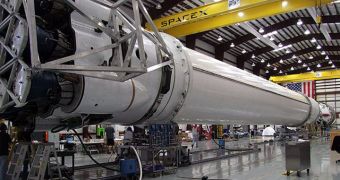Officials at the private spaceflight company Space Exploration Technologies (SpaceX) have recently announced that all the hardware components needed to launch the first full rocket into orbit have arrived at the launch pad. The take-off is scheduled to take place sometime in the spring, although no official launch date has yet been announced. The new Falcon 9 rocket will take off from the Space Launch Complex 40 (SLC-40), at the Cape Canaveral Air Force Station (CCAFS), in Florida.
The test vehicle will also be outfitted with a mock replica of the Dragon space capsule, which is being developed as a means of delivering supplies, equipment and scientific experiments to the International Space Station (ISS), after the space shuttles retire this September. SpaceX also wants to modify the capsule so as to obtain a spacecraft capable of carrying astronauts to the low-Earth orbit as well, but that goal is still some years away. With the new budget proposed for 2011, the company stands to win considerably from the $6 billion NASA received as grant money for the private sector.
The last components to be delivered at the SLC-40 facility also included the second stage of the rocket. The piece has just finished being tested in McGregor, Texas, at a facility SpaceX owns there. Now, engineers working with the company have a clear way towards beginning the full-vehicle integration process. The end-result will be a two-stage rocket some 154 feet (47 meters) in height, and 12 feet (3.6 meters) in diameter. “We expect to launch in one to three months after completing full vehicle integration. Our primary objective is a successful first launch and we are taking whatever time necessary to work through the data to our satisfaction before moving forward,” SpaceX Florida Launch Operations Director Brian Mosdell says.
As teams of engineers work on putting the large rocket together, other experts will conduct a further series of tests, including a static firing of the engines, so as to demonstrate that the vehicle is flight-worthy. SpaceX is under contractual obligation to perform a series of spaceflights with the Falcon 9 this year. It has signed a $1.6-billion deal with NASA, which states that it needs to fly at least 12 successful resupply missions to the ISS, carrying at least 20 tons of cargo each time, Space Fellowship reports.

 14 DAY TRIAL //
14 DAY TRIAL //